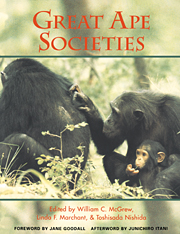Book contents
- Frontmatter
- Contents
- List of contributors
- Preface
- Foreword: conserving great apes
- Part I Apes overviewed
- Part II Social ecology
- Part III Social relations
- Part IV Minds
- Part V Apes compared
- 16 Comparative positional behavior of the African apes
- 17 Nest building behavior in the great apes: the great leap forward?
- 18 Comparative studies of African ape vocal behavior
- 19 On which side of the apes? Ethological study of laterality of hand use
- Part VI Modeling ourselves
- Afterword: a new milestone in great ape research
- Appendix: great ape study sites
- Index
17 - Nest building behavior in the great apes: the great leap forward?
Published online by Cambridge University Press: 04 August 2010
- Frontmatter
- Contents
- List of contributors
- Preface
- Foreword: conserving great apes
- Part I Apes overviewed
- Part II Social ecology
- Part III Social relations
- Part IV Minds
- Part V Apes compared
- 16 Comparative positional behavior of the African apes
- 17 Nest building behavior in the great apes: the great leap forward?
- 18 Comparative studies of African ape vocal behavior
- 19 On which side of the apes? Ethological study of laterality of hand use
- Part VI Modeling ourselves
- Afterword: a new milestone in great ape research
- Appendix: great ape study sites
- Index
Summary
INTRODUCTION
Over decades apes have served as either referential or conceptual models in attempts to reconstruct the path of human evolution (Ghiglieri, 1987; Wrangham, 1987). In the search for behavioral traits shared by all members of the great apes, few have turned out to be conservative, that is, common features seen in all extant hominoids, and by inference present in our common ancestor. Of these shared traits, skilled object manipulation has been of great interest in comparative analyses as a basic criterion for hominization. Tool use and tool production, however, vary tremendously not only among the four species but also within a single species. Thus the trait in common is not tool use itself, but the general ability for environmental problem solving (McGrew, 1992). Nest building is part of this ability. It is probably the most pervasive form of material skill in apes. Whether or not this trait should be considered as tool use is much disputed (Goodall, 1968; Alcock, 1972; Beck, 1980; Galdikas, 1982).
Nest building is called ‘bed building’ by some investigators (Itani, 1979; Hiraiwa-Hasegawa, 1986). It is a daily habit of weaned great apes to build a place in which to rest. The technique employed depends on the site and on the available materials. Orangutans, chimpanzees and bonobos start their arboreal constructions by preparing a foundation of solid sidebranches or forks, bending, breaking and inter-weaving sidebranches crosswise.
- Type
- Chapter
- Information
- Great Ape Societies , pp. 225 - 240Publisher: Cambridge University PressPrint publication year: 1996
- 80
- Cited by



